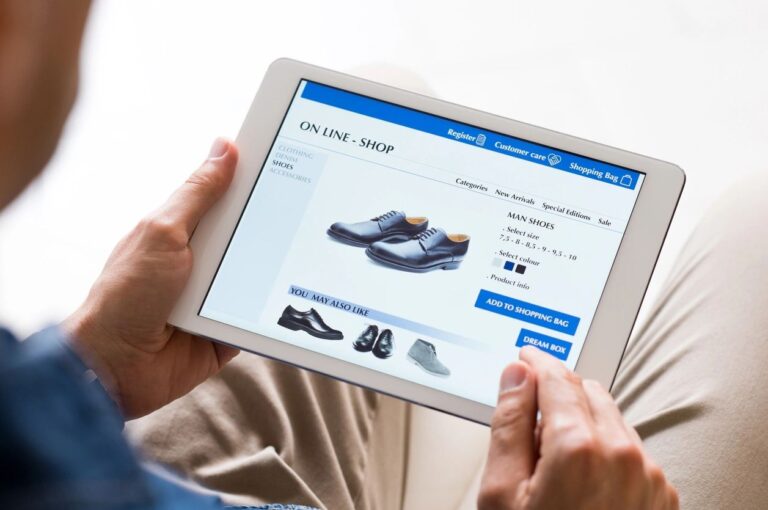Are you looking for information on how to start a dropshipping business with no money but don’t have a lot of capital to invest upfront? Or perhaps you’re tired of managing inventory and shipping logistics on your own. That’s where dropshipping comes in – it’s a business model that allows you to sell products without ever handling them yourself.
Instead, you work with suppliers who handle storage, packaging, and shipping. In more technical terms, dropshipping is a supply chain management method in which the retailer does not keep goods in stock but instead transfers customer orders and shipment details to either the manufacturer or wholesaler who then ships the goods directly to the customer.
This may sound complex, but it’s actually quite simple once you get started. In fact, one of the main advantages of dropshipping is its simplicity – all you need is an online store and a willingness to learn! Advantages of Dropshipping
So why should you consider dropshipping as your next entrepreneurial venture? There are several compelling advantages:
1. Low Startup Costs: As mentioned earlier, one of the biggest appeals of dropshipping is that it requires minimal upfront investment.
You don’t need to buy inventory or rent warehouse space – all you need is a website.
2. Flexibility: With no physical inventory to manage, you can run your business from anywhere with an internet connection.
This means you can work from home, while traveling abroad, or wherever else suits your lifestyle.
3. No Shipping Hassles: Shipping can be one of the most time-consuming aspects of running an e-commerce business – but with dropshipping, it’s taken care of for you!
Your supplier handles all shipping and tracking information once orders are placed on your website.
4. Wide Range Of Products To Sell: With access to thousands (if not millions)of products from various suppliers around the world at any given time , there’s always something new to sell.
In short, dropshipping is the ideal business model for those who want to start an e-commerce store without having to worry about the logistics of owning a physical inventory. The low startup costs and flexibility make it an attractive option for anyone looking to become their own boss and start their entrepreneurial journey. Lets start learning how to start dropshipping…
Researching Products
How to start a dropshipping first steps: Finding profitable products to sell
One of the first steps in starting a successful dropshipping business is identifying what products you want to sell. It’s important to find products that have high profit margins and are in demand.
There are a few different methods for doing this research. One popular method is using Google Trends, which can show you what items people are searching for online.
Another way to find profitable products is by browsing popular online marketplaces like Amazon or eBay and seeing what items are selling well. This can give you an idea of what types of products are currently in demand.
Identifying target audience
Once you’ve identified some potential products, it’s important to think about who your target audience is. Who would be interested in buying these items? Are there any specific demographics or interests that would make someone more likely to purchase them?
One way to identify your target audience is by conducting market research. You can use online surveys or interviews with potential customers to gather information about their preferences and buying habits.
Evaluating competition
Before deciding on a product to sell, it’s important to evaluate the competition. Are there already established businesses selling similar products? How many other dropshippers are already offering these same items?
You can use tools like Google AdWords Keyword Planner or SEMrush to analyze your competition and see how they’re marketing their products online. This information can help you determine whether there’s room for your business in that niche, or whether it may be too crowded already.
Choosing a Platform
Now that you’ve found some profitable products to sell, it’s time to choose the best platform for your business. There are plenty of e-commerce platforms out there, so let’s go over some of the most popular options and their pros and cons.
Overview of Popular E-Commerce Platforms
Shopify: One of the most popular e-commerce platforms out there. It’s easy to use and has plenty of features to help you run your store efficiently.
You can also choose from hundreds of templates to customize your store to your liking. However, it can be quite expensive if you need advanced features.
BigCommerce: Another popular option with similar features to Shopify. However, it offers better scalability for businesses that plan on growing quickly.
On the downside, it lacks some customization options that other platforms offer.
Magento: A great option for larger businesses with more complex needs.
It’s open-source, meaning you can fully customize your site as needed. However, it requires a higher level of technical proficiency than other platforms.
Pros and Cons of Each Platform
Shopify Pros:
- User-friendly interface
- Lots of templates available
- Huge app store for additional features
- Fully hosted – no need for separate hosting service
Shopify Cons:
- Much more expensive than other options on this list (plans start at $29/mo)
- If you want advanced features like abandoned cart recovery or gift cards, you’ll need to pay extra
- Transaction fees apply unless you use Shopify Payments
- Customization options are somewhat limited without knowledge of coding
BigCommerce Pros:
- Scalable for larger businesses
- No transaction fees (except for third-party payment processors like PayPal)
- Tons of built-in features, including gift cards and abandoned cart recovery
- No coding required to customize your site
BigCommerce Cons:
- Limited customization options compared to other platforms on this list
- Slightly more expensive than some other options (plans start at $29.95/mo)
- The interface can be a bit overwhelming at first glance, especially for novice users.
Magento Pros:
- The most customizable option on this list – you can pretty much do whatever you want with your site.
- No transaction fees for using Magento Payments.
- A huge community of developers and users available to help with any issues you may encounter.
Magento Cons:
- You’ll need some technical proficiency to make the most out of Magento’s flexibility.
- No built-in customer support – you’ll have to rely on the community or hire your own developers if needed.
Selecting the Best Platform for Your Business
When choosing the best platform for your dropshipping business, you’ll want to consider factors such as your budget, the level of customization you need, and the features you require. If you’re just starting out and want an easy-to-use platform with plenty of support, Shopify is a great option.
On the other hand, if you have more complex needs or a larger business that needs room to grow, Magento might be more up your alley. Ultimately, it’s up to personal preference and your own specific needs.
Don’t be afraid to try out a few options before settling on one. Many platforms offer free trials so that you can see which one works best for your business before committing.
Finding Suppliers
Researching suppliers through online directories and marketplaces
When it comes to finding suppliers, one of the best ways is to utilize online directories and marketplaces. Some popular options include Alibaba, Oberlo, and AliExpress. These platforms offer a vast selection of products from different suppliers around the world.
By browsing through these directories, you can find a supplier that offers the products you want to sell. It’s essential to research each supplier thoroughly before making a decision.
Look at their product offerings, pricing, shipping fees, and reviews from previous customers. This information will give you an idea of how reliable they are and their level of customer service.
Contacting suppliers to establish relationships
Once you’ve found some potential suppliers, reach out to them to establish a relationship. Most suppliers have contact information available on their profiles or websites.
You can send them an email or message with inquiries about their products and any other questions you may have. When contacting suppliers for the first time, be professional in your approach.
Introduce yourself and explain what you’re looking for specifically. Ask about pricing details, delivery times and shipping methods.
Evaluating supplier reliability and product quality
After establishing contact with potential suppliers, it’s important to evaluate their reliability and product quality carefully. Look at reviews from previous customers on the supplier’s profile page or website.
You can also request samples of products before making bulk orders if possible so that you can check the quality first hand.This way,you will avoid any issues that may arise because of poor quality merchandise.The better the quality,your chances of getting repeat business is high as well as positive feedback from clients which is important when starting out in this business! ,having reliable suppliers is crucial when starting a dropshipping business.Therefore,it’s essential to take your time in researching your suppliers and choose wisely.
Building Your Website
Creating a professional-looking website using free website builders like Wix or WordPress
Building a website can be intimidating, especially if you don’t have any prior experience in web design. Fortunately, there are many free website builders out there that make it easy for anyone to create a professional-looking site without spending any money.
Two of the most popular website builders are Wix and WordPress. Wix is an intuitive drag-and-drop builder that offers hundreds of templates for you to choose from.
You can easily customize your chosen template with your own branding elements, product descriptions, and images. The platform also offers a wide range of tools and apps to help you optimize your site for search engines and improve its functionality.
WordPress is another popular option that offers more flexibility than Wix but requires a bit more technical know-how. What makes WordPress so powerful is the vast selection of plugins available to users, allowing you to add features such as subscription forms, contact forms, image galleries, and more.
Customizing your website with branding elements, product descriptions, and images
Once you’ve chosen your website builder platform and selected a template that fits your business needs, it’s time to customize it with branding elements like logos, color schemes, banners etc. This will help give your online store an identity that customers can identify with easily. When writing product descriptions for your site ensure they are informative but not too lengthy or outright boring as this will lead potential customers away from the site quickly.
High-quality images are also essential in building trust between you and the customer as they provide them with visual evidence of what they’re buying which helps establish transparency between both parties. Building a high-quality online store is critical when starting dropshipping as this will be where all transactions take place between you and potential customers making sure it looks professional plays a vital role in establishing credibility for the business.
Social Media Marketing Strategies: Facebook and Instagram
One of the best ways to get your dropshipping business off the ground is by leveraging social media platforms like Facebook and Instagram. Both of these platforms have billions of active users, making them great for reaching a large target audience.
Here are a few tips for creating effective social media marketing strategies:
- Create a Business Page: First things first, create a dedicated Facebook or Instagram page for your business. This will allow you to showcase your products, share updates, and engage with potential customers.
- Post Consistently: To keep your followers engaged, it’s important to post regularly on your business page. Aim for at least one post per day, but make sure the content is high-quality and relevant to your niche.
- Use Paid Advertising: If you have room in your budget, consider running paid ads on Facebook or Instagram. This can help you reach an even larger audience and drive more traffic to your website.
Influencer Marketing Tactics: Finding Influencers in Your Niche
Influencer marketing involves partnering with social media influencers who have large followings in your niche. By working with influencers, you can tap into their audiences and promote your products to potential customers. The key is finding the right influencers to work with.
Here are some tips for finding influencers in your niche:
- Use Hashtags: Do some research on hashtags that are popular within your niche. Look for posts that have a high engagement rate (lots of likes and comments), as this may indicate that the user has a large following.
- Search Social Media Platforms: Use search functions on Facebook, Instagram, and Twitter to find influencers who are posting about topics related to your niche. You can also use tools like BuzzSumo or Hootsuite to find trending content and influencers.
- Reach Out: Once you’ve identified potential influencers, reach out to them with a proposal for a partnership. Be clear about what you’re offering and what you expect in return (e.g. product reviews, sponsored posts).
Email Marketing Techniques: Building an Email List
Email marketing is another effective way to promote your products to potential customers. By building an email list, you can send targeted promotions and updates directly to people who have expressed interest in your business.
Here are some tips for building an email list:
- Create Opt-In Forms: place opt-in forms on your website where visitors can sign up for email updates or special offers.
- Incentivize Sign-Ups: offer a discount or freebie in exchange for signing up for your email list.
- Promote Your List: share links to your opt-in forms on social media and other online platforms where potential customers might be hanging out.
To maximize the effectiveness of your email campaigns, be sure to segment your list based on interests or purchase history. This will allow you to send more targeted messages that are relevant and valuable to each individual subscriber.
Managing Orders and Customer Service
Setting up an Efficient Order Fulfillment System using Oberlo or AliExpress
Once you have set up your website and started driving traffic to it, you will begin receiving orders. That’s when a proper order fulfillment system comes into play.
You need to ensure that orders are processed, fulfilled, and shipped in a timely manner. To do this efficiently, you can use dropshipping tools like Oberlo or AliExpress.
Oberlo is a dropshipping app that allows you to easily import products from AliExpress into your online store. With just one click, you can add products to your store and fulfill orders automatically.
It also tracks inventory levels and alerts you when stock levels are running low so that you can reorder items in time. AliExpress is an online marketplace where you can source products for your dropshipping business at wholesale prices.
It has millions of products from thousands of suppliers around the world and offers various shipping methods worldwide. When using AliExpress as a supplier for your dropshipping business, it’s important to carefully evaluate each supplier’s reliability and product quality before placing an order.
Handling Customer Inquiries and Complaints Professionally
Customer service is essential for any business, including a dropshipping business. Providing excellent customer service helps build customer loyalty and trust in your brand.
You must be prepared to handle inquiries promptly when they arise. When customers reach out with questions or concerns regarding their purchase, make sure you respond quickly with concise answers that address their issues effectively.
Make use of email templates or automate certain aspects of communication where possible using chatbots or other software. If customers raise complaints about late shipments or damaged products, address these issues promptly by offering compensation if necessary (such as free replacements or refunds).
Keep track of all complaints received so that patterns can be identified over time as a way of improving your business. By providing excellent customer service, you can turn negative experiences into positive ones, strengthening your brand reputation in the long run.
Starting a dropshipping business doesn’t have to be expensive, as there are free ways to get started. First, you need to research the products you want to sell and identify your target audience.
Next, you should choose a platform that suits your business needs and start building your website using free website builders like Wix or WordPress. After that, you need to find reliable suppliers and establish relationships with them.
Once your website is up and running, it’s time to focus on marketing your products using social media marketing strategies, influencer marketing tactics, and email marketing techniques. You also need to set up an efficient order fulfillment system using tools like Oberlo or AliExpress while simultaneously managing customer inquiries and complaints professionally.
Starting a dropshipping business can be an exciting opportunity for anyone looking for financial independence or just wanting some extra income. With the right amount of research, dedication, and hard work, it’s possible to build a successful business from scratch without any significant investment.
Remember that starting any business requires patience and persistence. Don’t be afraid of failure; learn from it instead!
Keep in mind that success won’t happen overnight but with persistence comes progress. Take action today by following the steps outlined above and make your dreams a reality!




